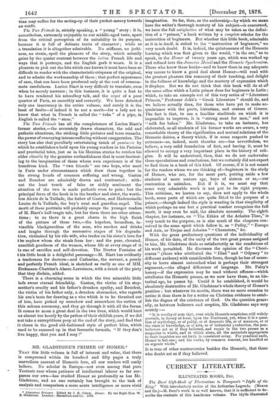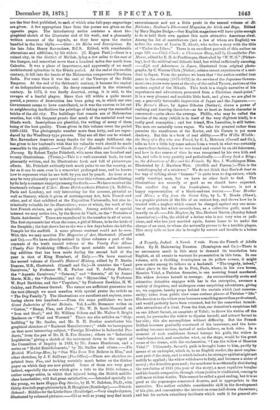CURRENT LITERATURE.
ILLUSTRATED BOOKS, Erc.
The Dore" Gift-Book of Illustrations to Tennyson's "Idylls of the King." With introductory notice of the Arthurian Legends. (Moxon and Co.)—M. Dores work is so well known, that it is sufficient to de- scribe the contents of this handsome volume. The idylls illustrated are the four first published, to each of which nine full-page engravings are given. A few appropriate lines from the poems are given on the opposite pages. The introductory notice contains a short bio- graphical sketch of the illustrator and of his work, and a pleasantly written account of the legends, as they bear upon the stories handled in the four idylls.—Gaur : its Ruins and Inscriptions. By the late John Henry Ravenshaw, B.C.S. Edited, with considerable alterations and additions, by his widow. (C. Kogan Paul.)—Gaur is a ruined city, in the district of Maldeb, lying a few miles to the east of the Ganges, and somewhat more than a hundred miles due north from Calcutta. It was a place of importance, and apparently of no small architectural splendour in the Hindu period. At the end of the twelfth century, it fell into the hands of the Alahometan conquerors of Northern India. For some time it was the seat of the Viceroys of the Delhi Emperor. At the end of the thirteenth century, it became the capital of an independent monarchy. Its decay commenced in the sixteenth -century. In 1575, it was finally deserted, owing, it is said, to the ravages of a fearful plague. Since then till within a quite recent period, a process of destruction has been going on, to which our own Government seems to have contributed, as it was the custom to let out to neighbouring landholders the privilege of taking away the enamelled bricks of the old city. The buildings that remain are of Mahometan erection, but with frequent proofs that much of the material used was Hindu work. Inseriptions are plentiful, the writing of many of them being of the best quality. Those given in this volume cover the period 1809-1535. The photographs number more than forty, and are repro- elaced by the Woodbury-type process. They are all that can be wished. Mrs. Rarenshaw deserves many thanks for the ample fulfilment she has given to her husband's wish that his valuable work should be made aceessible to the public.—" Goode Norge ;" Rambles and Scrambles in Norway. By Robert Taylor Pritchett, with more than one hundred and twenty illustrations. (Virtue.)--This is a well-executed book, its text pleasantly written, and its illustrations fresh and full of picturesque effects. Mr. Pritchett evidently took much pains to see the country, as far as it can bo seen even in a somewhat prolonged tour, and ho knows bow to represent what he saw both by pen and by pencil. An hour or so may be very pleasantly spent in looking over this volume, and meditating by its help a summer campaign among the fiords.—We have received the fourteenth volume of L'Art: Revue ilebdomadaire illustree (A. Ballibre, Paris and London), not only interesting for the account, pictorial as well as literary, which it gives of contemporary Art, both French and other, and of that exhibited at the Exposition Universelle, but also in- trinsically valuable for its illustrations, some of which, the work of the best French etchers, are quite admirable. Among articles of special interest we may notice two, by the Baron de Vinck, on the " Portraits of Marie Antoinette." These are reproduced to the number in all of seven. The first represents her when she came, a girl of fifteen, to be the bride of the Dauphin ; the last shows her as she was a few days before she left the Temple for the scaffold. A more piteous contrast could not be seen. With this we may mention The Magazine of Art, illustrated. (Cassell and Co).—We have already noticed in these columns a part of the contents of the tenth annual volume of the Vanity Fair Album (Vanity Fair Publishing Offiee).--The most notable and interest- ing addition that has been made during the second half of the year is that of King Humbert, of Italy.—We have received the second volume of Casseles Natural History, edited by P. Martin Duncan, M.D., illustrated. (Cassell and Co.)—It contains the "Land Carnivore," by Professor W. K. Parker and T. Jeffrey Parker ; the "Aquatic Carnivore," " Cetacea," and " Sorenia," all by James Murie, M.D.; the "Proboscidia," and the " Hyracoidea," by Professor W. Boyd Dawkins, and the "Ungulate," by Professor Dawkins, H. W. Oakley, and Professor Garrod. The names are sufficient guarantee for the text (though we must mention with special praise the article on "The Dog Family.") The illustrations are excellent and copious, num- bering above two hundred.—From the same publishers wo have Great Industries of Great Britain. Vol. L—Mr. Bremmer writes on "Cotton," "Hemp, Flax, and Jute ; " Mr. W. D. Scott-Moncrieff on "Iron and Stool;" and Mr. William Gibson and Mr. Walter S. Bright Maclaren on "Wool and Worsted." There are also articles on " Ship- building " by Mr. Smiles, and Mr. R. H. Dunbar contributes bio- graphical sketches of Eminent Manufacturers ;" while we have papers on that most interesting subject, "Foreign Rivalries in Industrial Pro- ducts," from the pen of Mr. H. R. Fox Bourne ; others on "Industrial Legislation," giving a sketch of the movement down to the report of the Committee of Inquiry in 1833, by Mr. James Henderson, and a series on "Model Establishments," by Mr. Smiles and others.—The British Working-Man, by "One Who Does Not Believe in Him," and other sketches, by J. F. Sullivan (Fun Office).—These are sketches re- printed from Fun, and looking certainly much better on the thicker paper on which they are now printed. Some of them are very good indeed, especially the series which give a title to the little volume, a rather savage satire, in which that injured being, the British middle- class householder, will find great satisfaction.—Intended specially for the young, we have Happy-Day Stories, by H. W. Dalcken, Ph.D., with thirty-five full-page pictures byA. B. Houghton (Routledge).—Schnick- Schnack: Riddles for the Little Ones (Routledge).—Very simple rhymes, illustrated by coloured pictures.—Old as well as young may find much entertainment and not a little profit in the annual volume of St. Nicholas; Scribner's illustrated Magazine for Girls and Boys. Edited by Mary Maples Dadge.—Our English magazines will have quite enough to do to hold their own against this most attractive American rival. Among the list of contributors (not a few of whom are English) we notice the name of Louisa M. Alcott, who mites a story with the title of "Under the Lilacs." There is an excellent portrait of this author on page 129. —Click-Clack : a Christmas Story, fold by Grandfather Pot- Mouse, edited by E. H. de Fonblanque, illustrated by "F. W. G." (Picker- ing), is of the satirical and didactic kind, but withal sufficiently amusing. —Life and Adventures in Japan, illustrated from original photo- graphs, by C. Warren Clark (Nisbet), relates recent experiences of a resi- dent in Japan. From the preface we learn that "the author resided four years in the country (1871-1875) in the service of the Japanese Govern- ment; two years were spent at the city of the exiled Tycoon, and two at the modern capital of the Mikado. This book is a simple narrative of his experiences and adventures, presented from a Christian stand-point." It is a very pleasant and readable little book, and gives, we are glad to say, a generally favourable impression of Japan and the Japanese.— The Rector's Home, by Agnes Giberne (Seeleys), shows a power of realising and drawing character—as far at least as female character is concerned—quite above the average. Phillis, who may be called -the heroine of the story (which is in itself of the very slightest kind), is a really good conception ; and her friend, Mrs. Lascelles, is still better. The men are naturally more vague. We take for granted rather than perceive the excellences of the Rector, and his Curate is yet more shadowy. But this is a book of real ability.— Wee Willie Winkle: the Story of a Boy who was Found, by C. L. Matdaux (Cassell and Co.), tells us how a little boy came ashore from a wreck in what was certainly a marvellous fashion, how he was found and reared by an old fisherman, and how in due course of thee ho was recognised by his own kith and kin, and tolls it very prettily and pathetically.—Erery Inch a King ; or, the Adventures of Rex and his Friends. By Mrs. J. Worthingon Bliss. Illustrated by J. Harrison Weir. (Griffith and Farran.)—This is the "autobiography of a retriever." We do not think that Rex's de haut en bas way of talking about " humans " is quite true to dog-nature, which really worships man, but we have no other fault to find. The illustrations are scarcely so good as we should have expected. The smaller dog on the flontispieco, for instance, is not a happy representation of a black-and-tan terrier.—Your Brother and Mine ; a Cry from the Great City, by L. T. Meade (Shaw), is a graphic picture of the life of an outcast boy, and shows how he is treated with a neglect which cannot ho charged against any one mem- ber of society, but which nevertheless, as a collective guilt, must lie heavily on all.—Ida Mayhew, by Mrs. Herbert Martin (Sunday School Association).—Ida, the child of a father who is not very wise or judi- cious, and who has just married again, loaves homo to he under the charge of an aunt, to whom she naturally proves to be a terrible plague. This story tolls us how she is brought by sorrow and trouble to a better mind.



































 Previous page
Previous page